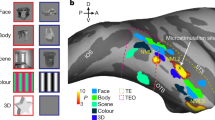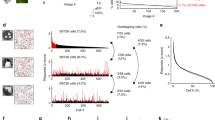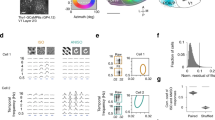Abstract
Intrinsic signal imaging from inferotemporal (IT) cortex, a visual area essential for object perception and recognition, revealed that visually presented objects activated patches in a distributed manner. When visual features of these objects were partially removed, the simplified stimuli activated only a subset of the patches elicited by the originals. This result, in conjunction with extracellular recording, suggests that an object is represented by a combination of cortical columns, each of which represents a visual feature (feature column). Simplification of an object occasionally caused the appearance of columns that were not active when viewing the more complex form. Thus, not all the columns related to a particular feature were necessarily activated by the original objects. Taken together, these results suggest that objects may be represented not only by simply combining feature columns but also by using a variety of combinations of active and inactive columns for individual features.
This is a preview of subscription content, access via your institution
Access options
Subscribe to this journal
Receive 12 print issues and online access
$209.00 per year
only $17.42 per issue
Buy this article
- Purchase on Springer Link
- Instant access to full article PDF
Prices may be subject to local taxes which are calculated during checkout







Similar content being viewed by others
References
Gross, C. G., Rocha-Miranda, C. E. & Bender, D. B. Visual properties of neurons in inferotemporal cortex of the Macaque. J. Neurophysiol . 35, 96–111 (1972).
Perrett, D. I., Rolls, E. T. & Caan, W. Visual neurones responsive to faces in the monkey temporal cortex. Exp. Brain Res. 47, 329–342 (1982).
Desimone, R., Albright, T. D., Gross, C. G. & Bruce, C. Stimulus-selective properties of inferior temporal neurons in the macaque. J. Neurosci. 4, 2051–2062 (1984).
Tanaka, K., Saito, H., Fukada, Y. & Moriya, M. Coding visual images of objects in the inferotemporal cortex of the macaque monkey. J. Neurophysiol. 66, 170–189 (1991).
Kobatake, E. & Tanaka, K. Neuronal selectivities to complex object features in the ventral pathway of the macaque cerebral cortex. J. Neurophysiol. 71, 856–867 (1994).
Ts'o, D. Y., Frostig, R. D., Lieke, E. E. & Grinvald, A. Functional organization of primate visual cortex revealed by high resolution optical imaging. Science 249, 417–420 (1990).
Blasdel, G. G. Orientation selectivity, preference, and continuity in monkey striate cortex. J. Neurosci. 12, 3139–3161 (1992).
Das, A. & Gilbert, C. D. Long-range horizontal connections and their role in cortical reorganization revealed by optical recording of cat primary visual cortex. Nature 375, 780–784 (1995).
Roe, A. W. & Ts'o, D. Y. Visual topography in primate V2: multiple representation across functional stripes. J. Neurosci. 15, 3689–3715 (1995).
Ghose, G. M. & Ts'o, D. Y. Form processing modules in primate area V4. J. Neurophysiol. 77, 2191–2196 (1997).
Malonek, D., Tootell, R. B. & Grinvald, A. Optical imaging reveals the functional architecture of neurons processing shape and motion in owl monkey area MT. Proc. R. Soc. Lond. B Biol. Sci. 258, 109–119 (1994).
Wang, G., Tanaka, K. & Tanifuji, M. Optical imaging of functional organization in the monkey inferotemporal cortex. Science 272, 1665–1668 (1996).
Wang, G., Tanifuji, M. & Tanaka, K. Functional architecture in monkey inferotemporal cortex revealed by in vivo optical imaging. Neurosci. Res. 32, 33–46 (1998).
Uchida, N., Takahashi, Y. K., Tanifuji, M. & Mori, K. Odor maps in the mammalian olfactory bulb: domain organization and odorant structural features. Nat. Neurosci. 3, 1035–1043 (2000).
Gochin, P. M., Miller, E. K., Gross, C. G. & Gerstein, G. L. Functional interactions among neurons in inferior temporal cortex of the awake macaque. Exp. Brain. Res. 84, 505–516 (1991).
Fujita, I., Tanaka, K., Ito, M. & Cheng, K. Columns for visual features of objects in monkey inferotemporal cortex. Nature 360, 343–346 (1992).
Marr, D. & Nishihara, H. K. Representation and recognition of the spatial organization of three-dimensional shapes. Proc. R. Soc. Lond. B Biol. Sci. 200, 269–294 (1978).
Biederman, I. Recognition-by-components: a theory of human image understanding. Psychol. Rev. 94, 115–147 (1987).
Ullman, S. Computation of pattern invariance in brain-like structures. Neural Net. 12, 1021–1036 (1999).
Edelman, S., Grill-Spector, K., Kushnir, T. & Malach, R. Toward direct visualization of the internal shape representation space by fMRI. Psychobiology 26, 309–321 (1998).
Ishai, A., Ungerleider, L. G., Martin, A., Schouten, J. L. & Haxby, J. V. Distributed representation of objects in the human ventral visual pathway. Proc. Natl. Acad. Sci. USA 96, 9379–9384 (1999).
Wang, Y., Fujita, I. & Murayama, Y. Neuronal mechanisms of selectivity for object features revealed by blocking inhibition in inferotemporal cortex. Nat. Neurosci. 3, 807–813 (2000).
Baylis, G. C., Rolls, E. T. & Leonard, C. M. Selectivity between faces in the responses of a population of neurons in the cortex in the superior temporal sulcus of the monkey. Brain Res. 342, 91–102 (1985).
Yamane, S., Kaji, S. & Kawano, K. What facial features activate face neurons in the inferotemporal cortex of the monkey? Exp. Brain Res. 73, 209–214 (1988).
Hasselmo, M. E., Rolls, E. T., Baylis, G. C. & Nalwa, V. Object-centered encoding by face-selective neurons in the cortex in the superior temporal sulcus of the monkey. Exp. Brain Res. 75, 417–429 (1989).
Sakai, K. & Miyashita, Y. Neural organization for the long-term memory of paired associates. Nature 354, 152–155 (1991).
Erickson, C. A. & Desimone, R. Responses of macaque perirhinal neurons during and after visual stimulus association learning. J. Neurosci. 19, 10404–10416 (1999).
Shtoyerman, E., Arieli, A., Slovin, H., Vanzetta, I. & Grinvald, A. Long-term optical imaging and spectroscopy reveal mechanisms underlying the intrinsic signal and stability of cortical maps in V1 of behaving monkeys. J. Neurosci. 20, 8111–8121 (2000).
Acknowledgements
We thank K.S. Rockland, R. Kado, K. Tanaka, and S. Edelman for comments on the manuscript, M. Fukuda for technical assistance throughout the experiments, and M. Matsumoto for modifying the data acquisition program. This project was partly supported by Precursory Research for Embryonic Science and Technology (PRESTO), Japan Science and Technology Corporation.
Author information
Authors and Affiliations
Corresponding author
Rights and permissions
About this article
Cite this article
Tsunoda, K., Yamane, Y., Nishizaki, M. et al. Complex objects are represented in macaque inferotemporal cortex by the combination of feature columns. Nat Neurosci 4, 832–838 (2001). https://doi.org/10.1038/90547
Received:
Accepted:
Issue Date:
DOI: https://doi.org/10.1038/90547
This article is cited by
-
The Cognitive Philosophy of Reflection
Erkenntnis (2022)
-
Methodological aspects for cognitive architectures construction: a study and proposal
Artificial Intelligence Review (2021)
-
Optical intrinsic signal imaging with optogenetics reveals functional cortico-cortical connectivity at the columnar level in living macaques
Scientific Reports (2019)
-
Visual and Category Representations Shaped by the Interaction Between Inferior Temporal and Prefrontal Cortices
Cognitive Computation (2018)
-
Robust encoding of scene anticipation during human spatial navigation
Scientific Reports (2016)



